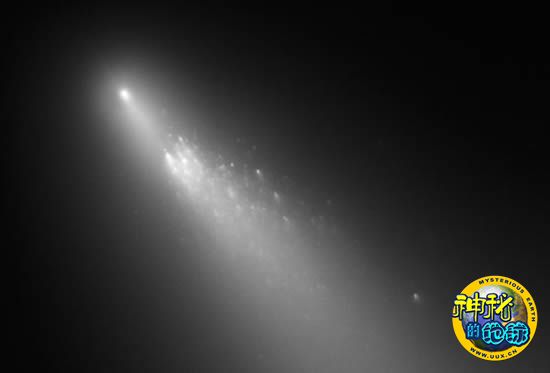Comet "Shower" Killed Ice Age Mammals?
A Hubble Space Telescope picture shows a comet breaking apart on April 18, 2006.
John Roach
for National Geographic News
Published April 7, 2010
The comet that created the annual Taurid meteor shower was also responsible for snuffing out large mammals in North America 13,000 years ago, a controversial new study says.
The geologic record shows that global temperatures plummeted by as much as 14 degrees Fahrenheit (8 degrees Celsius) just as Earth was thawing out from the last ice age.
This cold snap probably led to the extinction in North America of large animals such as saber-toothed cats and wooly mammoths. But scientists have been unsure what triggered the abrupt change.
For more than 15 years, astrobiologists Bill Napier and Victor Clube have argued that the culprit was a 30- to 60-mile-wide (50- to 100-kilometer-wide) comet that entered the inner solar system—the region between the sun and the asteroid belt, just past Mars's orbit—20,000 to 30,000 years ago.
In the new study, Napier, of Cardiff University in the U.K., suggests that the huge comet settled into a new, faster orbit around the sun and began to break apart, creating fragments that pummeled Earth about 13,000 years ago.
His model suggests that those pieces might still be visible today as the Taurid complex, a debris cloud that sends tiny meteors streaming through Earth's atmosphere in late October and early November. (See pictures of the Perseid meteor shower.)
The study, according to Napier, further bolsters the comet-impact theory, which many astronomers continue to dismiss.
"We are looking at this as an actual, reasonable, astrophysical mechanism," said Napier, whose paper is now online at arXiv.org and will appear in an upcoming issue of the Monthly Notices of the Royal Astronomical Society.
Taurid Link No More Than "Window Dressing"?
Napier made the connection between the Taurids and the mammal extinctions after hearing about evidence for microscopic nanodiamonds at Ice Age sites across North America. Such tiny diamonds are thought to form only during extraterrestrial impacts.
"When we see the evidence of nanodiamonds on the ground, it clicks," Napier said.
Also, a barrage of fiery comet fragments would explain the evidence for ancient wildfires found at many North American sites from this time period.
But many astronomers say the idea is improbable, because space rocks big enough to cause such a catastrophe aren't known to orbit so close to the sun.
"So this would be something pretty unusual," said Jay Melosh, an impact expert at Purdue University in Indiana, who remains unconvinced by the new study.
What's more, if an existing debris cloud did cause the ancient extinctions, there should still be threatening chunks in the inner solar system, argued Alan Harris, a senior researcher at the Space Science Institute in Colorado who studies impact hazards.
"An abrupt comet [or asteroid] shower is bit like, say, a stove fire that can fill the kitchen with smoke in a few seconds but takes many minutes to hours to clear out," Harris said in an email.
Surveys for such comet chunks show that "they simply aren't there in the numbers needed [to account for a giant, disintegrating comet]," Harris said.
"And what we do see are not in coherent or clustered orbits that could possibly have come from a single body" within the last 20,000 to 30,000 years.
According to Harris, the claim that the Taurid complex is linked to the North American extinctions "is just the most current window dressing for a broad hypothesis that has not yet been proven."












